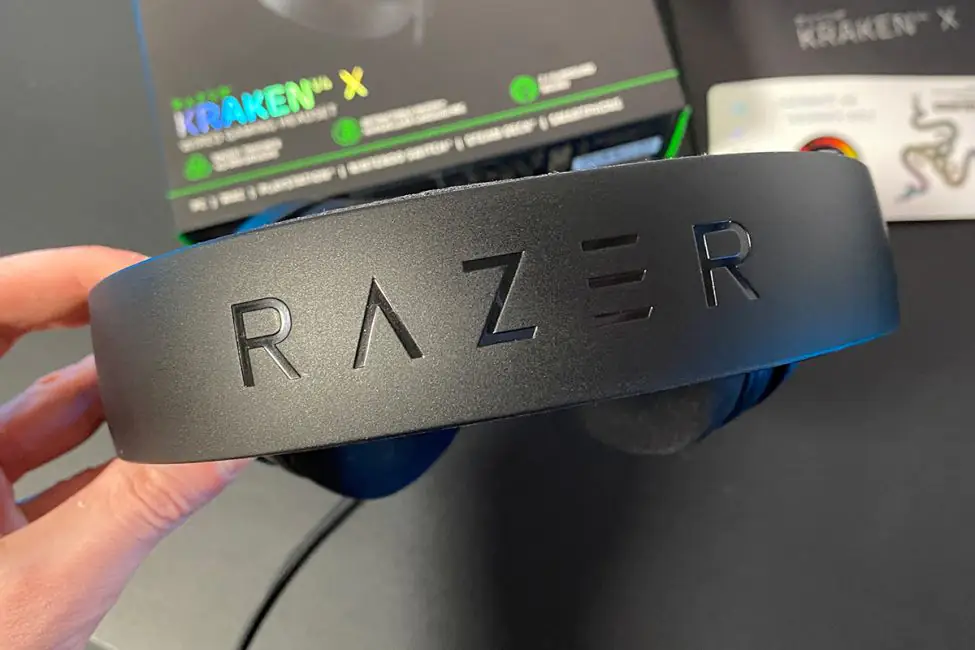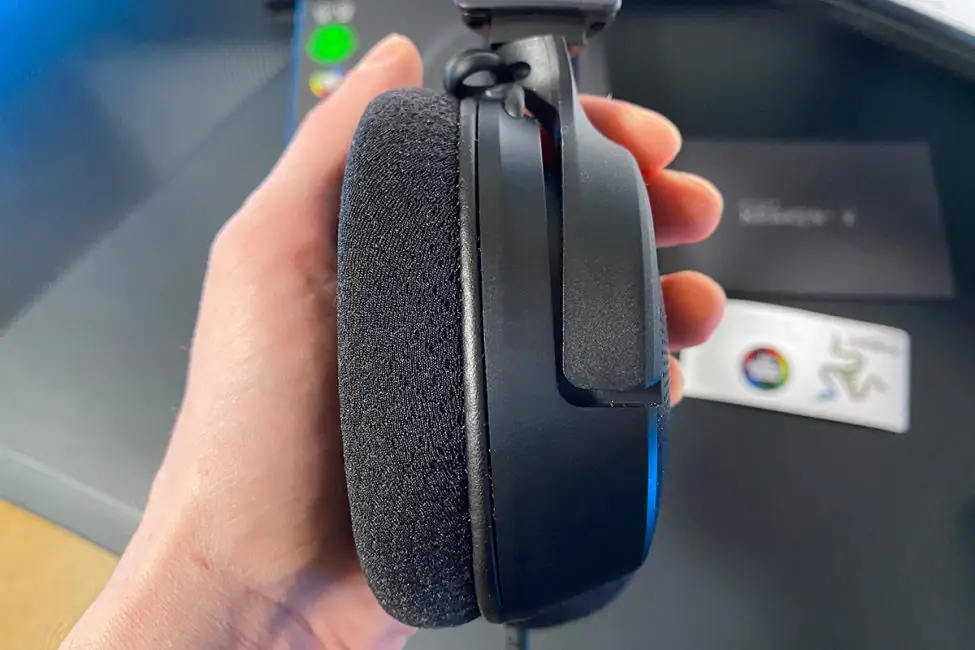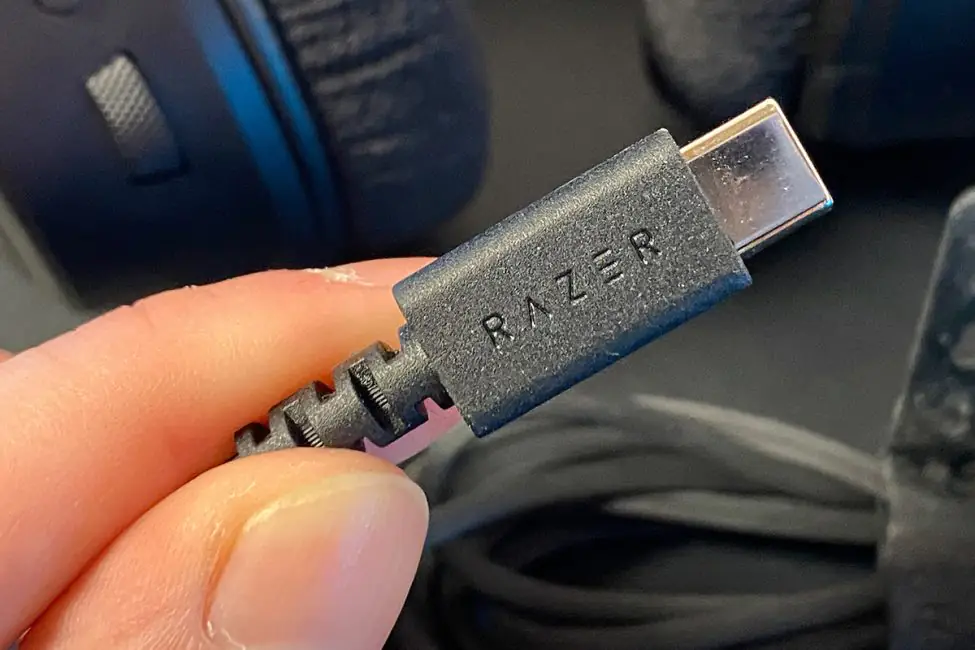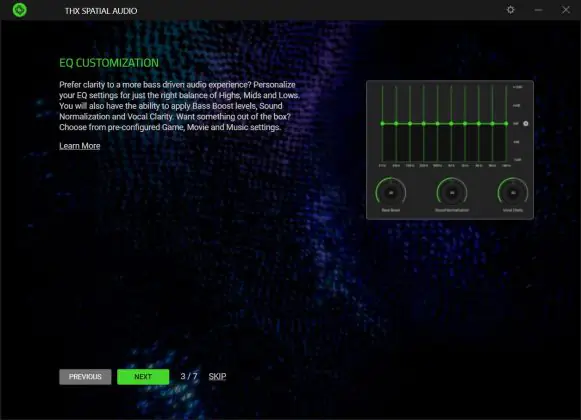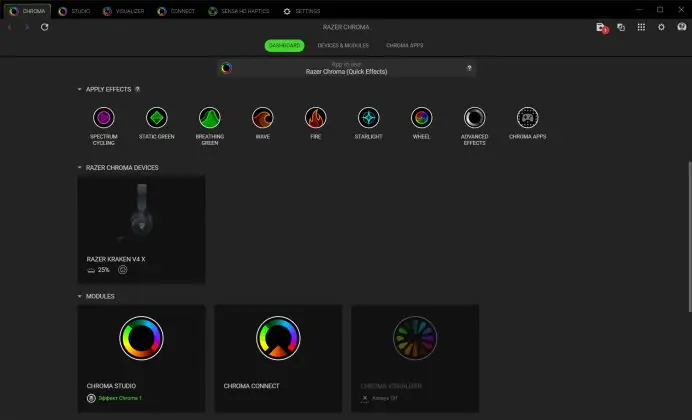© ROOT-NATION.com - Use of content is permitted with a backlink.
This year, Razer expanded its Kraken gaming headset lineup with three new models: the Kraken V4 Pro, Kraken V4, and Kraken V4 X. The Pro version stands out as the flagship model, offering top-tier features among gaming headphones. The Kraken V4 is positioned as a balanced, mid-range option. Finally, the Kraken V4 X is the most basic and budget-friendly model in the lineup.
This review focuses on the Kraken V4 X. How does it differ from the more expensive variants? What unique features, advantages, and drawbacks does it offer? How much does it cost, and is it worth the price? These questions will be explored in detail throughout the review.
Specifications
Understood. Please send the text you’d like me to translate and rewrite, and I’ll adjust it accordingly to maintain a neutral, professional tone suitable for a tech review.
As you can see, the Razer Kraken V4 X features slightly simpler drivers and a more basic microphone compared to the other models. Instead of THX Spatial Audio for virtual surround sound, it offers standard 7.1 Surround Sound support. The headset is strictly wired, with USB-C or USB-A connectivity options, and has less extensive lighting effects.
It’s worth noting that the Pro version includes additional features, such as a dedicated OLED control panel and vibration functionality powered by Razer Sensa HD technology. However, those headphones belong to a completely different category, and since this review focuses on the Kraken V4 X, let’s return to this model.

From the screenshot above, one might assume that the Kraken V4 X lacks full support for THX Spatial Audio technology. However, I can confirm that this isn’t the case. I tested THX Spatial Audio with this model, and it worked perfectly. I’ll discuss this in more detail in the relevant section. That wraps up the key differences for now. If you’d like to compare the full specifications of the standard V4 and Pro versions, you can find them on Razer’s official website. Here, I’ll focus on the specifications for the Razer Kraken V4 X.
- Headphone type: full-size closed
- Connection method: wired (USB-C / USB-A)
- Drivers: Razer TriForce 40 mm with neodymium magnets
- Frequency range: 20-20000 Hz
- Impedance: 32 ohms at 1 kHz
- Sensitivity: 96 dB SPL/mW at 1 kHz (HATS)
- Noise reduction: passive noise reduction
- Ear cushions: oval, made of combined material (breathable FlowKnit fabric and artificial leather for sound insulation; filled with memory foam)
- Inner diameter of the headphone cup: 62×42 mm
- Adjustment: 90° swivel headphones; adjustable headband
- Controls on the ear cup: volume control wheel, microphone mute button, LED microphone mute indicator
- Microphone type: retractable Razer HyperClear cardioid microphone
- Microphone pattern: unidirectional
- Microphone frequency range: 100 – 10000 Hz
- Microphone sensitivity: -42 ± 3 dB at 1 kHz
- Microphone signal-to-noise ratio: ≥ 60 dB
- Surround sound: virtual 7.1 Surround Sound
- Proprietary software: Razer Synapse 4, Razer Synapse 3, Razer Chroma, 7.1 Surround Sound, THX Spatial Audio
- Backlighting: RGB (logo on headphone cups) compatible with Razer Chroma
- Supported platforms: PC, Mac, PlayStation, Nintendo Switch, Steam Deck, mobile devices, Android, iOS
- Cable: non-removable USB-C in a corrugated plastic sheath; length 2 m; USB-C to USB-A adapter
- Weight: 310 g
- Package contents: headset, USB-C to USB-A adapter, fabric case, documentation, branded stickers
Positioning and price
As mentioned earlier, the latest iteration of the Kraken headset series includes three models: the Kraken V4 Pro, the Kraken V4, and the Kraken V4 X. The first is a flagship model aimed at the top-tier market, offering premium features. The second strikes a balance between functionality and affordability. The third is a simplified and most budget-friendly option. For clarity, here are the prices of all three models:
- Razer Kraken V4 Pro – $482 / €455
- Razer Kraken V4 – $241 / €228
- Razer Kraken V4 X – $120 / €114
Package contents
The headset comes in a branded cardboard box with a recognizable Razer design. Headphones are included in the package:
- Razer Kraken V4 X headset
- USB-C to USB-A adapter
- fabric case for the headset
- user manual
- Razer branded stickers

Overall, the Kraken V4 X comes with a fairly standard package. One thoughtful addition is the inclusion of a USB-C to USB-A adapter. Since the headset’s primary cable features a USB-C connector, the adapter significantly broadens compatibility, allowing the headset to connect to a wider range of devices.

Compatible devices
Overall, the Kraken V4 X comes with a fairly standard package. One thoughtful addition is the inclusion of a USB-C to USB-A adapter. Since the headset’s primary cable features a USB-C connector, the adapter significantly broadens compatibility, allowing the headset to connect to a wider range of devices.

It’s worth noting upfront that the 7.1 surround sound and THX Spatial Audio features are only functional on Windows devices. To enable these features, you’ll need to activate and install additional software. I’ll cover the setup process in more detail later, but for now, let’s focus on the headset itself.

Read also:
- Razer DeathAdder V3 HyperSpeed Wireless Gaming Mouse Review
- Razer DeathAdder V3 Pro review: an advanced gaming mouse
Design, ergonomics, build quality
The Razer Kraken V4 X is a full-sized, closed-back gaming headset with a design that embodies a classic gaming aesthetic. Its build is large and robust, with a bold and slightly aggressive appearance. The headset features Razer’s signature logos and customizable RGB lighting fully compatible with Razer Chroma. As for color options, the headset is only available in black.
The headband is made of plastic, offering a wide, flexible design that securely holds the ear cups without causing pressure on the head. On the outside of the headband, you’ll find Razer’s signature logo. Inside, there’s a soft padding covered with a pleasant fabric where the head makes contact. While the material of the padding isn’t specified, it feels very similar to the ear cup cushioning. The ear cups themselves are made of a combination of breathable FlowKnit fabric and artificial leather for sound isolation, filled with memory foam for added comfort.
The adjustment range is quite large, making the headset comfortable for both small and large heads. For example, the headphones fit me perfectly right from the start.

The ear cups are oval-shaped and quite large. They can rotate 90°. On the outside of the ear cups, you’ll find the signature Razer logos with backlighting, fully compatible with Razer Chroma. The internal diameter of each ear cup is 62×42 mm.
The ear cushions are full-sized and of a closed-back design. They are made from a combination of materials — breathable FlowKnit fabric and synthetic leather for sound isolation. The padding inside the ear cups uses memory foam. The cushions feel very soft and pleasant to the touch. They fully cover the ear, leaving a bit of extra space inside. This helps prevent discomfort, fatigue, or sweating even during extended use. The passive noise isolation is also quite impressive. While the headphones don’t feature active noise cancellation, they do a good job blocking out ambient sounds (such as conversations, TV noise, keyboard typing, mouse clicks, and sounds from the street through an open window).
The cable, microphone, and all control elements are located on the left ear cup. The cable is non-detachable and is encased in a textured plastic sheath (slightly rubberized to the touch) with a total length of 2 meters. It features a standard USB-C connector. The cable itself is fairly durable, bends well, and holds its shape. While it would be nice if the cable were a bit softer and lighter, most gaming headsets come with similar cables. This design ensures that the cable is robust enough to avoid being bent, pinched, or detached.
The microphone is retractable and non-detachable. When retracted, it fully hides within the left ear cup. When extended to its maximum length, the microphone measures approximately 12 cm. The microphone features an LED indicator: when the light is red, the microphone is off, and when there is no lighting, it is on.
As for the controls, there are only two of them: the volume control wheel and the microphone on/off button (MUTE).

The dial on the headset is used solely for adjusting the volume. It’s not possible to completely mute the sound with it. The dial itself is quite functional, providing clear feedback with each turn, and the adjustment increments are set to four levels (PC/Windows). While it would have been nice to have finer adjustments, such as in two-step increments, this is a minor detail. The only issue I have with the dial is that it feels too soft. It could be a bit stiffer, as it’s easy to accidentally adjust the volume when adjusting the headset on your head. However, this isn’t a major problem, and you get used to it over time.

The MUTE button toggles the headset’s microphone on and off. Pressing the button is accompanied by a voice notification in the headphones (mic ON / mic OFF), which is a handy feature.

The build quality of the headset is excellent, without exaggeration. There are no unwanted creaks, play, or any signs of poor assembly. All the components are precisely aligned. In short, the build quality is top-notch. The ergonomics are also impressive. The headphones fit comfortably on the head, with no pressure on the ears even after 6 hours of continuous use. At the same time, the ears feel free in the ear cups and do not sweat at all.

Read also:
- Razer Leviathan V2 X gaming soundbar review: not just for gamers
- Razer Basilisk V3 Pro Review: The Perfect Flagship Gaming Mouse?
Features and sound quality
The Kraken V4 X features Razer’s proprietary 40mm TriForce drivers with neodymium magnets. The frequency range spans from 20 Hz to 20,000 Hz. The impedance is 32 ohms at 1 kHz, and the sensitivity is 96 dB SPL/mW at 1 kHz using HATS. According to Razer, the patented three-part design of the driver provides exceptional reproduction of high, mid, and low frequencies without distortion, offering a more dynamic listening experience and deeper immersion.

I can partially agree with the statement above. The reason for partial agreement is that the Razer Kraken V4 X lacks some bass in regular stereo mode. However, the mid and high frequencies are indeed clearer compared to headphones that produce dense bass. From this, we can conclude that the Razer Kraken V4 X is ideally suited for gaming, which, as expected, is their primary purpose as a gaming headset. Listening to music in them is possible, but if you are accustomed to strong bass, you may experience some disappointment. In games, on the other hand, you will hear more details that are usually muffled by bass-heavy headphones.

A simple example: In Diablo IV, near the Whispering Tree in the swamps, where everyone hangs out in the endgame, with the Razer Kraken V4 X, I noticed the surrounding nature sounds for the first time. Crickets, wind, the forest noises, and all that. Before that, I played with Sony WH-XB900N headphones, which are not gaming headphones at all but have an amazing bass. However, with the WH-XB900N, all those surrounding sounds are there too, but they’re more in the background, so you don’t hear them as clearly. With the Razer Kraken V4 X, you actually start to pay attention to such details.

The same goes for S.T.A.L.K.E.R. 2: the nature sounds, ambient noises, and various details are much clearer, which enhances the immersion and makes the game more engaging. Honestly, I’ve always said that for quality music listening at home, you need one type of headphones, and for quality sound in games, you need another. After using the Kraken V4 X for a few weeks, I’ve only been further convinced of this belief. Of course, you could go for an all-in-one option, but something will inevitably suffer—whether it’s the bass, the details, or the positioning.

Speaking of positioning, with the basic settings in regular stereo mode, the Kraken V4 X does quite a good job positioning the sound in games. You can easily distinguish whether something is happening to the left, right, or behind you. There’s a separate 7.1 Surround Sound mode, but you need to activate and download additional software for it. However, based on my observations, not much changes with the 7.1 Surround Sound. It adds some sense of space, but it’s not very pronounced. The headphones truly shine with THX Spatial Audio — a spatial sound technology. I’ve mentioned before that if you just look at the specs, you might think Kraken V4 X doesn’t support THX. But I installed the software, and it worked fine with the headphones, significantly changing the sound.
With the activation of THX Spatial Audio, the headset sounds completely different. The sound becomes truly immersive, deep, and multi-layered. Positioning and immersion increase exponentially. But what’s most interesting is that the bass becomes noticeably stronger, something that’s lacking in the regular stereo mode. However, it’s important to note that this improvement also depends on the game you’re playing.
For example, in S.T.A.L.K.E.R. 2, some sounds can seem a bit unnatural. For instance, the music from the receivers sometimes sounds muffled, as if you’re standing behind a wall, even though the receiver is just to your left or right. Or the gunfire from the KRISS Vector (called “Integral-A” in the game) sounds too dull. No matter how many games I’ve played, I’ve never heard the Vector sound like that. Ambient sounds can also be overwhelming at times. But everything else sounds fantastic: weapon reloading and cocking, weather effects, wind, sounds during anomalies, and various little details. I was particularly impressed by the sound of trees bending in the wind—it felt like being in an incredible cinema, with the sound coming directly from you.
Another example is Battlefield 2042. The sound in this game with THX Spatial Audio is simply incredible. It’s immersive, deep, layered, and at the same time free from any unnatural sounds. The software even offers different profiles for the game. However, I must say that the “THX Spatial Audio” profile sounds the best. That said, to experience all of this beauty, you’ll need to purchase the THX Spatial Audio software separately. But I’ll dive into more details about that in my full review.
To summarize, what can I say about the sound of the Razer Kraken V4 X? It’s simply an excellent headset in standard stereo mode, and the spatial sound with THX activation is absolutely fantastic. However, it’s not ideal for music listening, which isn’t surprising. But for gaming, it’s truly top-notch.
Read also:
- ASUS ROG Keris II Ace Wireless Gaming Mouse and ROG Moonstone Ace L Surface Review
- Razer Cobra Pro gaming mouse review: comfort, charm and uniqueness
Microphone
The headset features a retractable unidirectional cardioid Razer HyperClear microphone. The frequency range spans from 100 to 10,000 Hz, with a sensitivity of -42 ± 3 dB at 1 kHz. The claimed signal-to-noise ratio is ≥ 60 dB.

The voice quality through the microphone, in my opinion, is quite good. It’s sufficient for coordinating actions or simply chatting with teammates in a game. It can also be used for work calls without issues. The voice is clear, not distorted, and with some effort, there’s minimal background noise. However, the microphone does pick up breathing sounds, and they are noticeable. For this reason, I think Razer could include a simple foam windscreen with the headset. It would serve as a filter, reducing breathing noise and other background sounds. This would be especially useful for people who plan to use the microphone frequently. Just extend it, turn it on, add the foam from the package, and you’re good to go. Below, I’ll include a sample of my voice recorded through the microphone.

Proprietary software
All headset settings are available in the Razer Synapse 4 app. You can also use the older version, Synapse 3, but personally, I don’t see much point in that, so let’s focus on the new version of the software.
There aren’t many headset settings in the app: sound, microphone, and lighting. In the “Sound” menu, you can adjust the headphone volume, access the volume mixer, adjust Windows sound properties, and launch the 7.1 Surround Sound app. What surprised me was the lack of any equalizer in the basic settings.
When you click on “7.1 Surround Sound,” you’ll be redirected to Razer’s official website to download a separate app. Upon launching the app, you’ll need to enter an activation code. To get the activation code, you must register your headset on the Razer website. After registering your profile and adding the device using its serial number, you’ll receive the code by email. The “7.1 Surround Sound” app itself looks like this (screenshot below). Essentially, it only allows you to toggle the 7.1 sound on or off and choose the playback device.
Я вже казав, що з активацією 7.1 Surround Sound кардинально звук не змінюється. Власне, тому я ним особливо і не користувався. Проте я вдосталь потестив THX Spatial Audio. Ось він вже кардинально змінює звук. THX Spatial Audio йде як платна додаткова програма. Коштує цей софт $19,99. Але є тріал на 15 днів, за які точно можна зрозуміти потрібно воно вам чи ні.
THX Spatial Audio is also downloaded and installed as a separate app. The settings include audio, an equalizer, calibration, and a demo. In the “Audio” menu, you can select the output device, compare sound between regular stereo and THX modes, adjust sound profiles for specific applications, and visit Razer’s official website to see the list of supported games. It’s important to note that all games support THX, though some have additional preset profiles for settings.
In the “Equalizer” menu, you’ll find a full equalizer, bass boost, sound normalization, and a “Clear Voice” function. It’s worth noting that this equalizer only works with THX.
In the “Calibration” menu, you can adjust individual sound channels and the playback distance. I didn’t use this menu much—I left all the settings at their defaults, and I was satisfied with the results as they were.
In the “Demo” menu, you can find a demo video that will show you all the benefits of THX technology.
In the “Microphone” menu, you can adjust the microphone input volume and immediately listen to your voice through the headphones.
In the “Lighting” menu, as you’d expect, you can adjust the lighting on the headphones. You can choose from four preset effects or go into advanced lighting settings for more customization.
Advanced lighting settings are available in a separate app, Razer Chroma Studio. Here, you can create custom lighting effects by layering different lighting patterns and sync the headphones’ lighting with other Razer devices.
Overall, the software from Razer is decent. It runs smoothly without bugs, and there are some nice features for syncing with their device ecosystem. However, the approach of using separate apps for everything—each of which needs to be downloaded, installed, and launched separately—is quite frustrating. Especially when compared to solutions like Armoury Crate or SteelSeries GG, where everything is in one place. Also, the lack of an equalizer in the headset’s basic settings feels a bit odd.
Read also:
- Razer Leviathan V2 X gaming soundbar review: not just for gamers
- GameSir G8 Plus review: There’s a New King In Town
Impressions of using
My overall impression of the headset is entirely positive. First and foremost, the ergonomics are excellent. The headphones fit perfectly on the head, with the ear cups fully covering the ears while still leaving a bit of space. They don’t exert any pressure on the head or ears, even during extended use. In fact, the Razer Kraken V4 X is the kind of headset I could comfortably wear all day.

The basic sound quality is excellent. The Razer Kraken V4 X delivers clear detail, which enhances immersion and the overall gaming experience. The positioning is good as well. However, they’re not ideal for music, as the bass is lacking. But as I mentioned before, this is a gaming headset, and it excels at that particular task.
THX Spatial Audio takes the sound of the Razer Kraken V4 X to a whole new level. With it, the sound becomes immersive, deep, and clear, making games sound completely different. However, in some games, certain sounds might feel a bit unnatural, like being too muffled or overly sharp—at least that’s my impression. On the other hand, many games sound excellent across the board. I’ve mentioned examples from S.T.A.L.K.E.R. 2 and Battlefield 2042. It seems that if a game is listed as supported on Razer’s website, the THX sound will work great with it, and additional profiles will be available. In other cases, the THX settings include an equalizer, which allows you to adjust the sound to your preference in any game.

The built-in microphone is simply adequate. It provides a clear and undistorted voice for gaming and work calls. Honestly, it does exactly what’s needed and nothing more.
Conclusions
In conclusion, I can say that the Razer Kraken V4 X, as the youngest model in the V4 lineup, is a solid performer. It’s an excellent headset on its own, with great sound, especially when THX is activated. The ergonomics are fantastic, the build quality is solid, the sound is great, and the microphone is decent. All of this comes at a very reasonable price. I’ve already detailed what I liked about the headset in the review, so to sum up: I would gladly use the Razer Kraken V4 X. Though, to be honest, I’ve long moved away from wired headphones, so I’d probably save up for the wireless version, the Kraken V4. In addition to wireless connectivity, the speakers and microphone on that model are likely to be a bit better. However, if wired headphones don’t bother you, or if you’re on a budget, I would definitely recommend considering the Kraken V4 X.
As for the downsides, I didn’t find any major ones. The only minor issue I’d point out is the lack of any kind of equalizer in the basic settings. And then there’s the Razer software overall. Specifically, it’s the approach where nearly every feature requires you to download and install something separately. Some might argue that the paid THX is a point of contention, but I don’t think so. The THX Spatial Audio is an optional extra feature. If you want it, buy it; if not, you don’t have to—nobody is forcing you. There’s a trial so you can try it out and decide for yourself. Personally, from what I’ve tested with THX, I concluded that I’d probably go for it. Of course, it does feel a bit costly, but in my opinion, it’s worth it, especially if you’re into shooters.

Read also:
- Top 5 Graphics Cards for S.T.A.L.K.E.R. 2: Heart of Chornobyl
- Hator Quasar 2 Ultra 4K Wireless Gaming Mouse Review
- Škoda Kamiq 2024 Review: Is This Compact SUV Crossover Worth Your Attention?








